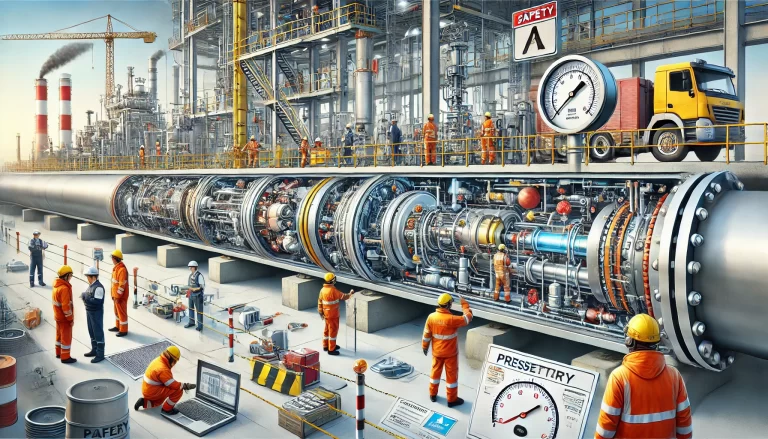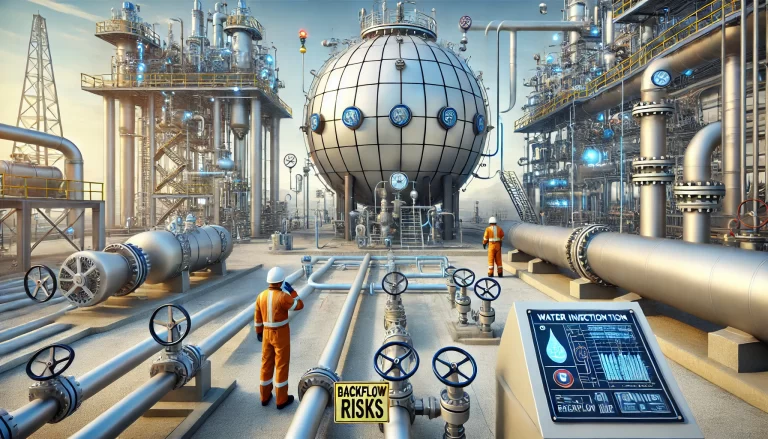Introduction
With the increasing number of pressure pipelines in various industries, safety management has become a critical concern. Many incidents related to pressure pipelines have been reported due to management loopholes, inadequate maintenance, and unforeseen failures. Therefore, understanding safety precautions, accident prevention strategies, and emergency response measures is crucial to ensuring pipeline integrity and minimizing risks.
1. Characteristics of Pressure Pipeline Accidents
Pressure pipeline accidents typically have the following characteristics:
1.1 Sudden Occurrence
Pressure pipeline accidents often occur unexpectedly without prior warning, making prevention and response challenging.
1.2 High Destructive Potential
Due to the high pressure and hazardous nature of the transported substances, accidents can result in severe damage, including property loss, environmental pollution, and human casualties.
1.3 Chain Reactions
A failure in one section of the pipeline can lead to subsequent failures in interconnected systems, amplifying the impact of the accident.
1.4 Complexity of Causes
Accidents may result from various factors, including material defects, improper design, substandard construction, operational errors, poor maintenance, and external influences such as natural disasters.
1.5 Severe Consequences
In industries such as petrochemicals and energy, pressure pipeline failures can trigger fires, explosions, and toxic gas leaks, posing significant threats to public safety and the environment.

2. Common Types of Pressure Pipeline Accidents
2.1 Pipeline Explosion
Excessive internal pressure can cause pipelines to rupture suddenly. This may occur due to operational errors, equipment failure, or poor maintenance.
2.2 Pipeline Leakage
Leaks can occur due to material fatigue, corrosion, mechanical damage, or faulty joints. Leaking hazardous substances can pose safety and environmental risks.
2.3 Fire and Explosion
Pipelines transporting flammable or explosive substances may cause fires or explosions if a leak ignites. Such incidents can result in extensive damage and loss of life.
2.4 Corrosion-Induced Failures
Chemical reactions between the transported medium and the pipeline material can lead to wall thinning and eventual structural failure.
2.5 Material Defects
Manufacturing defects, low-quality materials, or inappropriate material selection can result in premature pipeline failures.
2.6 Construction and Installation Issues
Poor workmanship during construction, including improper welding and lack of quality inspections, can introduce hidden defects that may lead to future failures.
2.7 External Influences
Natural disasters such as earthquakes, floods, or landslides, as well as human activities like accidental vehicle impacts, can compromise pipeline integrity.
3. Common Causes of Pressure Pipeline Accidents
3.1 Design Deficiencies
Lack of professional engineering qualifications.
Unapproved self-designed modifications.
Failure to meet regulatory design standards.
3.2 Welding Defects
Use of unqualified welders.
Incomplete or poorly executed welds, reducing strength.
Lack of post-weld inspections and non-destructive testing.
3.3 Material Issues
Incorrect material selection.
Use of substandard materials with surface defects.
3.4 Valve and Flange Failures
Worn-out or defective valve bodies and flanges.
Improperly rated valves used in incompatible environments.
3.5 Insufficient Safety Distance
Inadequate spacing between pipelines and critical infrastructure.
Proximity to residential or high-traffic areas, increasing risk exposure.
3.6 Lack of Safety Awareness
Poor understanding of hazardous materials.
Insufficient training in safe pipeline operations.
3.7 Operational Violations
Absence of or failure to enforce safety procedures.
Unauthorized or reckless operation of equipment.
3.8 Corrosion and Aging
Extended service life leading to material degradation.
Inadequate inspections and preventive maintenance.
4. Emergency Response Measures
4.1 Overpressure and Overtemperature Incidents
Operators must adjust valves and pressure release systems to bring parameters within safe limits.
Immediately notify maintenance teams to identify and eliminate hazards.
If safety is compromised, initiate system shutdown.
Inspect affected pipelines and safety accessories for anomalies.
Record and report incident details for future analysis.
4.2 Exceeding Rated Parameters
Operators must monitor system pressure and temperature and take corrective action.
If safety valves fail to reset, gradually reduce pressure and shut down operations.
If hazardous materials are released, follow emergency containment procedures.
Verify the integrity of safety valves and pressure relief systems.
4.3 Pipeline Leaks
Immediately depressurize and shut down the affected pipeline.
Alert emergency services (e.g., medical responders, fire department) if injuries or fires occur.
Isolate the leak area and prevent ignition sources.
Evacuate non-essential personnel and establish safety perimeters.
Contain leaks, disconnect affected sections, and redirect pipeline flow if necessary.
Assess environmental impact and implement spill response measures.
4.4 Structural Deformations and Vibrations
Identify and mitigate the source of excessive vibrations.
If structural integrity is at risk, shut down and inspect affected sections.

5. Prevention Strategies for Pressure Pipeline Accidents
5.1 Proper Design and Installation
Use straight-line layouts whenever possible.
Account for thermal expansion in parallel piping connections.
Install dual-valve isolation systems for hazardous gas pipelines.
5.2 Material Selection and Testing
Conduct rigorous non-destructive testing (NDT) on pipeline materials.
Use certified high-quality materials resistant to corrosion and pressure fluctuations.
Perform hydrostatic testing at 1.5 times the operating pressure post-installation.
5.3 Operational Safety
Conduct pre-startup safety checks and ensure proper pipeline purging.
Implement controlled shutdown procedures during power failures.
Enforce strict safety protocols for handling explosive gas mixtures.
5.4 Routine Maintenance and Inspection
Regularly inspect protective coatings to prevent corrosion.
Lubricate and test valve operations periodically.
Maintain pressure gauges and safety valves in optimal working condition.
Check and tighten bolts to ensure secure connections.
Address any signs of unusual vibrations, friction, or static charge buildup.
Inspect pipeline segments in critical areas such as crossings, bridges, and residential zones.
Take immediate corrective action for any abnormal pressure, leaks, or structural deformities.

Conclusion
Ensuring the safety of pressure pipelines requires a combination of preventive maintenance, rigorous inspections, proper training, and emergency preparedness. Companies must implement best practices in design, material selection, and operational safety to minimize risks. Additionally, fostering a strong safety culture and enforcing strict regulatory compliance can significantly reduce the likelihood of catastrophic pipeline failures. By taking a proactive approach to safety, industries can enhance pipeline reliability, protect lives, and mitigate environmental impacts.
